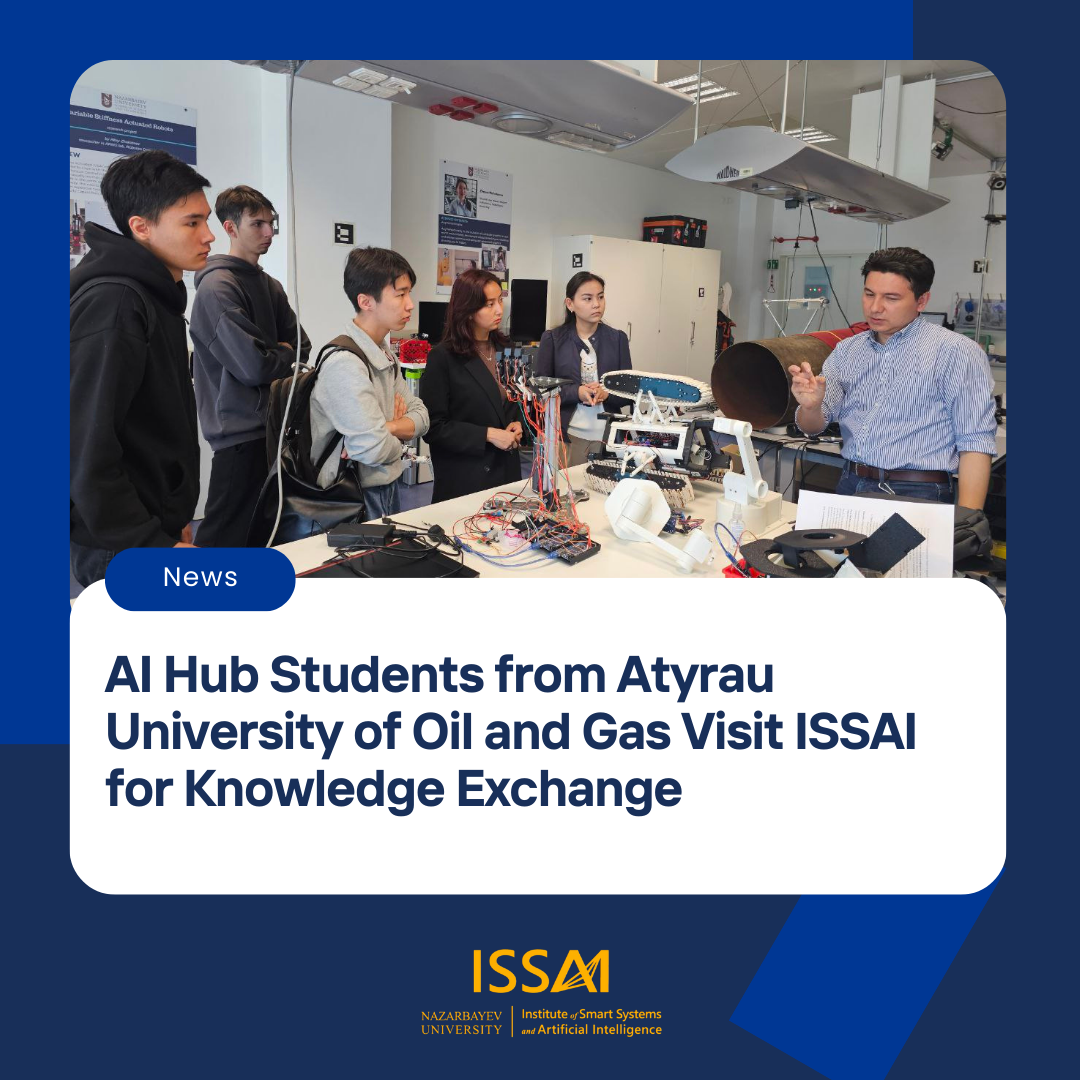From April 22 to April 25, 2025, students from the AI Hub artificial intelligence laboratory at the Atyrau University of Oil and Gas named after Safi Utebayev visited ISSAI at Nazarbayev University for an exchange of experience and laboratory tours. The members of the AI Hub are third-year students from the Faculty of Information Technology. The students expressed a strong interest in developing strategic cooperation in AI and digital technologies, as well as in studying best practices.
Aigerim Sarsenova, Senior External Affairs manager at ISSAI, provided an overview of the Institute’s current research areas and projects, emphasizing its key role in advancing AI in Kazakhstan. ISSAI showcased several of its prominent projects, including MangiSoz, Oylan, and Aibike, which highlight the Institute’s progress in AI-driven language learning, education, and research tools. The visitors also had the chance to engage with ISSAI’s data scientists and researchers, discussing the impact of these technologies on various sectors.
Research Assistants Hamad Hassan Awan and Sakiru Olarewaju Olagunju (PhD students of Nazarbayev University) presented their ongoing research, outlining key objectives and insights. Mr. Hamad discussed leveraging AI to strengthen circular economy practices by extracting actionable data and developing a structured index to guide professionals in implementing optimal strategies. Mr. Sakiru presented his PhD research on AI-driven processing of satellite images to estimate earthwork volume.
At the Advanced Robotics and Mechatronics Systems (ARMS) Lab, Azamat Yeshmukhametov introduced students to several innovative projects in robotics and automation. He demonstrated a hybrid robotic platform equipped with a manipulator for performing maintenance tasks inside pipes — a solution designed to operate in confined and hard-to-reach industrial environments. The group also explored a tensegrity structure developed at the lab, which uses a unique balance of tension and compression to achieve lightweight and highly adaptable robotic designs. These projects showcased how cutting-edge AI and robotics research can be applied to real-world engineering challenges.
Students expressed interest in the work of the Human-Robot Interaction Lab led by Professor Anara Sandygulova. This lab focuses on human-centered research to address socially important applications such as sign language recognition, autism therapy, and technology-enhanced learning. At this lab, Robotics master’s student at NU Zholaman Kuangaliyev presented a robot designed to interact with children with autism spectrum disorder (ASD). The system can sense, perceive, and act using multimodality such as gestures, facial expressions, audio, and natural language. This project is among several that contributed to the lab winning the Best Paper award at the HRI conference.
The students then proceeded to the Robot Control and Learning (RCL) Lab, which focuses on developing novel algorithms for robot control and motion planning. The Head of the RCL Lab, Professor Matteo Rubagotti, introduced ongoing projects carried out by his team, including a scenario-based model predictive control system that incorporates probabilistic human predictions to enable safe and effective human-robot coexistence.
The program of the students’ visit also included a tour to the Tactile Lab. This lab is known for its high-caliber work in the field of tactile sensors. Research Assistant at Tactile Lab Yermakhan Kassym presented the lab’s work on development of numerous devices that utilize haptic and tactile technology to address the challenges of various groups.
Following their visit to the Tactile Lab, the students were introduced to the anechoic chamber recently constructed at Nazarbayev University. Demonstrated by Professor Bakhtiyar Orazbayev, this specialized facility is utilized for a range of experiments requiring a controlled, soundproof environment. Notably, it is the only anechoic chamber of its kind in Kazakhstan, underscoring the university’s commitment to advanced research infrastructure.
The students also visited the Central Asia Innovation Food Lab, a joint mutli-displiabicnay project led by Professors Didier Talamona (SEDS), Dr Mei-Yen Chan (SOM) and Professor Atakan Varol (ISSAI). In the lab, the students explored how advanced technologies are applied in modern nutrition and food science applications. Research Assistants Rustem Orazbayev and Alina Zakeryanova introduced the lab’s work on food 3D printing and hyperspectral imaging, highlighting efforts to create localized high quality datasets unique to Central Asia, alternative food structures and evaluate food quality through cutting-edge imaging techniques.
Atyrau oil and gas students highlighted the valuable experience they had gained during their week-long stay in Astana. Moreover, this visit is of strategic importance in laying the groundwork for the establishment of the AI Hub artificial intelligence laboratory at the Atyrau University of Oil and Gas.
“We believe that this experience exchange and familiarization with artificial intelligence projects at ISSAI and Nazarbayev University will contribute to the successful implementation of our future projects,” said student Aliya Kussmanova.
The students were impressed by the high level of research at ISSAI, especially expressing their appreciation for ISSAI’s achievements in the development of numerous natural language processing datasets specifically for the Kazakh language. They expressed great interest in the work and projects of ISSAI and visited laboratories and had an excellent opportunity to ask questions to the creators of advanced projects in robotics, human-robot interaction, and control systems.



